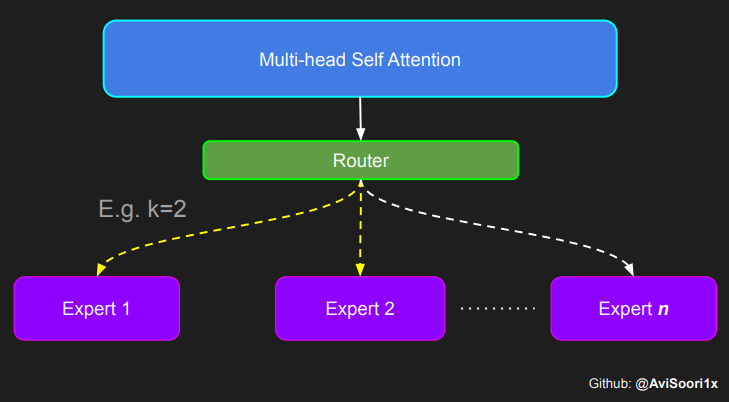从零开始的稀疏专家混合语言模型:用专家容量扩展 makeMoE
我之前的博客详细介绍了稀疏专家混合语言模型“makeMoE”的端到端实现(灵感来自 Andrej Karpathy 的 makemore 和 nanoGPT),并获得了社区的广泛关注(https://huggingface.co/blog/AviSoori1x/makemoe-from-scratch)。最近,x.ai 开源了另一个稀疏 MoE LLM Grok-1,这进一步促使我通过加入一个我最初遗漏的功能——专家容量——来增强 makeMoE。
这里提供的 Github 仓库提供了端到端的实现(包含专家容量):https://github.com/AviSoori1x/makeMoE
为什么专家容量如此重要?
在预训练稀疏专家混合语言模型或任何大型语言模型时,该过程通常涉及多个 GPU,甚至许多机器。训练在这些硬件资源上的并行方式对于平衡计算负载至关重要。然而,如果某些专家或一组专家过于受偏爱——这反映了对利用而非探索的偏好——不仅可能导致模型性能问题,还会导致集群计算负载的不平衡。
Switch Transformer 的实现通过专家容量来规避这个问题。专家容量决定了每个专家在训练或推理过程中负责处理的 token 数量,并对每个专家处理的 token 数量设定了限制。它根据批次中的 token 数量和可用专家的数量来定义,通常通过容量因子进行调整。这个因子允许在分配上具有灵活性,提供了缓冲区以适应数据分布的变化,并确保没有单个专家由于过载而成为瓶颈。在训练这些大型模型数周甚至数月时,硬件故障很常见,因此这非常重要。
专家容量通常按以下方式计算:
专家容量 = (每批次 Token 数 / 专家数量) × 容量因子,其中:
每批次 Token 数是指需要处理的批次中存在的 Token 总数。专家数量是指 MoE 层中可用于处理数据的专家总数。容量因子是一个乘数,用于调整基本容量(每批次 Token 数除以专家数量)。容量因子大于 1 允许每个专家处理超出均匀分配份额的缓冲区,以适应 Token 分配中的不平衡。这个值的通常范围是 1-1.25。
以下代码块对实现一个简单版本的专家容量进行了轻微调整。
class SparseMoE(nn.Module):
def __init__(self, n_embed, num_experts, top_k, capacity_factor=1.0):
super(SparseMoE, self).__init__()
self.router = NoisyTopkRouter(n_embed, num_experts, top_k)
self.experts = nn.ModuleList([Expert(n_embed) for _ in range(num_experts)])
self.top_k = top_k
self.capacity_factor = capacity_factor
self.num_experts = num_experts
def forward(self, x):
# Assuming x has shape [batch_size, seq_len, n_embd]
batch_size, seq_len, _ = x.shape
gating_output, indices = self.router(x)
final_output = torch.zeros_like(x)
# Flatten the batch and sequence dimensions to treat each token independently
flat_x = x.view(-1, x.size(-1)) # Now shape [batch_size * seq_len, n_embd]
flat_gating_output = gating_output.view(-1, gating_output.size(-1))
tokens_per_batch = batch_size * seq_len * self.top_k
expert_capacity = int((tokens_per_batch / self.num_experts) * self.capacity_factor)
updates = torch.zeros_like(flat_x)
for i, expert in enumerate(self.experts):
expert_mask = (indices == i).any(dim=-1)
flat_mask = expert_mask.view(-1)
selected_indices = torch.nonzero(flat_mask).squeeze(-1)
limited_indices = selected_indices[:expert_capacity] if selected_indices.numel() > expert_capacity else selected_indices
if limited_indices.numel() > 0:
expert_input = flat_x[limited_indices]
expert_output = expert(expert_input)
gating_scores = flat_gating_output[limited_indices, i].unsqueeze(1)
weighted_output = expert_output * gating_scores
updates.index_add_(0, limited_indices, weighted_output)
# Reshape updates to match the original dimensions of x
final_output += updates.view(batch_size, seq_len, -1)
return final_output
为了确保形状对齐(这在此类实现中很常见),需要进行大量的张量形状操作,但实现中最重要的部分仅在几行代码中。让我们放大看看这些部分。
首先,让我们看一下专家容量的计算。
expert_capacity = int((tokens_per_batch / self.num_experts) * self.capacity_factor)
这非常简单。将其包含在前向传播中,是为了应对使用动态批次大小的情况。
下一行重要的代码是:
limited_indices = selected_indices[:expert_capacity] if selected_indices.numel() > expert_capacity else selected_indices
if limited_indices.numel() > 0:
#remaining logic to process and accumulate weighted expert outputs for selected tokens.
`selected_indices` 张量标识了指定由第 i 个专家处理的 token。如果分配给该专家的 token 总数超过其容量,则该张量将被截断以匹配专家的最大处理容量。否则,它将按原样用于进一步的计算。
这些计算包括通过专家确定每个 token 的输出,然后应用相应的门控值以得出加权输出。此加权输出逐步与最终输出张量结合,从而构成模型的整体输出。
包含实现的 Jupyter Notebook 在这里:https://github.com/AviSoori1x/makeMoE/blob/main/makeMoE_from_Scratch_with_Expert_Capacity.ipynb
这种管理专家容量的方法相对基础。在文献中探索了更高级的策略,例如 Google 论文中讨论的 Switch Transformer 架构,可在此处获取:https://arxiv.org/abs/2101.03961。尽管此处提出的方法简化了容量处理,但它为这一概念提供了一个直观的介绍,并使 makeMoE 更加完整!
